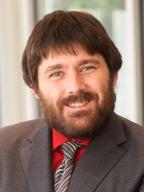
Biography
EDUCATION
B.S. Iowa State University of Science and Technology, 2007
Ph.D. Texas A&M University, 2012
POSTDOCTORAL APPOINTMENTS
Instituit de Physique Nucléaire d'Orsay, 2012 - 2014
Texas A&M University, 2015-2017
COURSES TAUGHT
TBD
RESEARCH INTERESTS
Analytical / Physical Chemistry
Dr. Eller’s research interests are in mass spectrometry, material characterization, and nanoscale chemical analysis. Specifically, Dr. Eller is interested in developing new instrumentation and analytical methods for nanoscale molecular characterization using massive cluster secondary ion mass spectrometry, SIMS. SIMS is an analytical tool which using atomic, polyatomic, or cluster projectiles to bombard a surface the impact of the projectile results in the emission of neutrals, ions, electrons, and photons. The ions are collected and mass analyzed to generate a mass spectrum. The mass spectrum will contain elemental and molecular information from the topmost part of the surface. SIMS is a well-known tool for elemental analysis of materials in the semiconductor industry. However, as the limit of traditional semiconductor materials is quickly approaching its limit, new hybrid materials such as organic light emitting diodes, OLED, are increasingly important. Thus, new instrumental methodologies for molecular characterization and evaluation of these organic/inorganic hybrid materials at the nanoscale is critical.
To meet the challenge of characterizing the molecular composition of materials at the nanoscale our lab is developing new instrumental tools and analytical methods. The goal of the instrumental research is to promote the emission of molecular species using novel massive cluster projectiles. To interpret the results from these novel projectiles we measure the energy, and angular distribution of emitted molecular species with a unique mass spectrometer allowing us to understand the physical mechanisms which lead to increased molecular emission.
1) Nanoscale molecular characterization of surfaces
- Collaborative research projects will center on using the current instrumentation to evaluate surfaces for co-localized molecules and determine surface homogeneity. Two projects are currently underway; i) determining how the structure of the nanoparticle influences ligand attachment on individual particles. ii) examining the chemical composition of photoresist materials to determine the effect of development on device performance and the effect of additives and changes to the preparation method.
2) Testing Novel Projectiles – Massive clusters massive emission?
- New instrumentation will be developed at CSUN to generate novel massive clusters of gold exceeding 500 kdal in mass. This involves determining the conditions in the ion source to promote the emission of these clusters, characterizing the impact crates with high resolution electron microscopy, and measuring the abundance and properties of ejected molecular ions/fragment ions.
3) Analytical and statistical methods
- The analysis of nano-objects with SIMS can be challenging, especially as the size of the object approaches the size of the impacting cluster. To meet this challenge new statistical and software tools will be used to unfold the complex data set. This will include using multivariate tools paired to the multidimensional data obtained during the experiment.
REPRESENTATIVE PUBLICATIONS
- Nanoprojectile Secondary Ion Mass Spectrometry for Analysis of Extracellular Vesicles, D.S. Verkhoturov, B.P. Crulhas, M.J. Eller, Y.D. Han, S.V. Verkhoturov, Y. Bisrat, A. Revzin, E.A. Schweikert, Analytical Chemistry, 2021, 93 (20), 7481–7490.
- Label Free Particle-by-Particle Quantification of DNA Loading on Sorted Gold Nanostars, M. J. Eller, K. Chandra, E. E. Coughlin, T. W. Odom, E. A. Schweikert, Analytical Chemistry, 2019, 91 (9), 5566-5572
- Nanoscale molecular analysis of photoresist films with massive cluster secondary-ion mass spectrometry, M. J. Eller, M. Li, X. Hou, S.V. Verkhoturov, E. A. Schweikert , P. Trefonas, J. Micro/Nanolith. MEMS MOEMS, 2019, 18(2), 023504
- Molecular Co-localization with Massive Gold Clusters, M.J. Eller, A. Vinjaumuri, B. Tomlin, E.A. Schweikert, Analytical Chemistry, 2018, 90(21), 12692-12697
- The collision of a hypervelocity massive projectile with free-standing graphene: Investigation of secondary ion emission and projectile fragmentation, S. Geng, S. V. Verkhoturov, M. J. Eller, S. Della-Negra, E. A. Schweikert, Journal of Chemical Physics, 2017, 146, 054305.
- Testing Molecular Homogeneity at the Nanoscale with Massive Cluster Secondary Ion Mass Spectrometry, M.J. Eller, S.V. Verkhoturov, E.A. Schweikert, Analytical Chemistry, 2016, 88 (15) 7639-7646.
- Hypervelocity nanoparticle impacts on free-standing graphene: A sui generis mode of sputtering, M. J. Eller, C.K. Liang, S. Della-Negra, A. B. Clubb, E.A. Schweikert, Journal of Chemical Physics, 2015, 142, 044308.
- Time-of-flight secondary ion mass spectrometry imaging of biological samples with delayed extraction for high mass and high spatial resolutions, Q.P. Vanbellingen, N. Elie M.J. Eller, S. Della-Negra, D. Touboul, A. Brynelle, Rapid Communications in Mass Spectrometry, 2015, 29(13), 1187-1195.
- SIMS Instrumentation and Methodology for Mapping of Co-localized Molecules, M. J. Eller; S. V. Verkhoturov; S. Della-Negra; E. A. Schweikert; Review of Scientific Instruments, 2013, 84, 103706.
- Nanoscopic Cylindrical Dual Concentric and Lengthwise Block Brush Terpolymers as Covalent Preassembled High-Resolution and High-Sensitivity Negative-Tone Photoresist Materials, G. Sun; S. Cho; C. Clark; S. V. Verkhoturov; M. J. Eller; A. Li; A. Pavía-Jiménez; E.A. Schweikert; J. W. Thackeray; P. Trefonas; K. L. Wooley; Journal of the American Chemical Society, 2013, 135 (11), 4203–4206.
- Noradrenaline-Functionalized Hyperbranched Fluoropolymer-Poly(Ethylene Glycol) Cross-Linked Networks as Dual-Mode, Anti-Biofouling Coatings, P.M. Imbesi; N.V. Gohad; M.J. Eller; B. Orihuela; D. Rittschof; E.A. Schweikert; A.S. Mount; K.L. Wooley, ACS Nano, 2012, 6(2)2 1503-1512.
M. S. THESES
